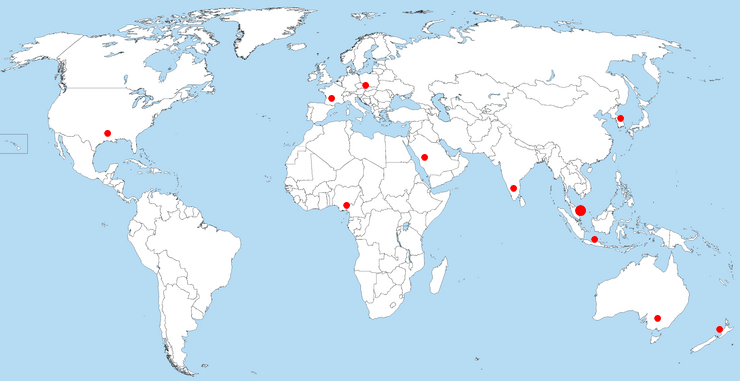PERFORMANCE STUDY OF SOLAR THERMAL BINARY POWER CYCLES
Keywords:
Binary power cycles, solar thermal, organic rankine cycles, parametric study, cycle efficiency.Abstract
The purpose of this study is to evaluate the performance of solar thermal binary power generating system. The system will consist of two cycles, which is solar superheated steam cycle and the organic Rankine cycle. Three organic fluids, isobutane, R123 and R245fa will be used in the study and will be compared with R134a. The primary heat energy is captured from solar energy is used for superheated steam power cycle. The rejected heat from condenser of the steam cycle is used as heat input for the organic Rankine cycle. The temperature differences in the condenser of steam cycle and evaporator of the organic Rankine cycle range from 10°C to 15°C. The total work is produced by the two turbines from these two cycles. The performance is measured based on work and efficiency of the cycles. For organic Rankine cycle, it is found that refrigerant R123 gives the highest efficiency among refrigerant R245fa, R134a and isobutane. It was found that, the maximum work from the combination of the two cycles is from solar steam/isobutane which can produce 613.22 kJ/kg work. This combination of solar Rankine cycle and organic Rankine cycle produce 542.4 kJ/kg and 70.82 kJ/kg maximum works respectively. Both of these solar superheated Rankine cycle and organic Rankine cycle achieve 19.76 % and 16.87 % efficiency respectively.References
Chena Power. 2010, from http://www.chenapower.com/geothermal-power/
Cheng Eng Cong, Sanjayan Velautham., Amer Nordin Darus. (2005). Solar Thermal Organic Rankine Cycle as a Renewable Energy Option. Jurnal Mekanikal, No. 20, 68 - 77.
Delgado-Torres, A. M., & Garcia-Rodriguez, L. (2010). Analysis and optimization of the low-temperature solar organic Rankine cycle (ORC). Energy Conversion and Management, 51(12), 2846-2856.
Hettiarachchia, H. D. M., Golubovica, M., Worek, W. M., & Ikegami, Y. (2007). Optimum design criteria for an Organic Rankine cycle using low-temperature geothermal heat sources. Energy, 32(9), 1698-1706.
Holdmann, G. (2007). The Chena Hot Springs 400kW geothermal power plant: Experience gained during the first year of operation.
Lund, J. W. (1981). Chena Hot Springs, Alaska. Geo-Heat Center Quarterly Bulletin, Vol. 6(No. 3), 23-25.
Price, H., Lupfert, E., Kearney, D., Zarza, E., Cohen, G., Gee, R., et al. (2002). Advances in Parabolic Trough Solar Power Technology. Journal of Solar Energy Engineering, 124(2), 109-125.
Younglove, B. A. and Ely, J. F., (1987). Thermophysical Properties of Fluids. II. Methane, Ethane, Propane, Isobutane and Normal Butane. J. Physc. Chem. Ref. Data, 16(No 4), 578-798.
Younglove, B. A. and Mclinden, M. O. (1994). An International Standard Equation of State for the Thermodynamic Properties of Refrigerant-123 (2,2-Dichloro-1,1,1- Trifluoroethane). Journal of Physical and Chemical Reference Data, 23(5), 731-779.
Lee, B. S. C. a. J. (2006, August 15, 2006). "Saguaro Solar Power Plant, Red Rock, Arizona." from http://www.powermag.com/renewables/solar/Saguaro-Solar-PowerPlant-Red-Rock-Arizona_468.html
Downloads
Published
How to Cite
Issue
Section
License
Copyright of articles that appear in Jurnal Mekanikal belongs exclusively to Penerbit Universiti Teknologi Malaysia (Penerbit UTM Press). This copyright covers the rights to reproduce the article, including reprints, electronic reproductions or any other reproductions of similar nature.







